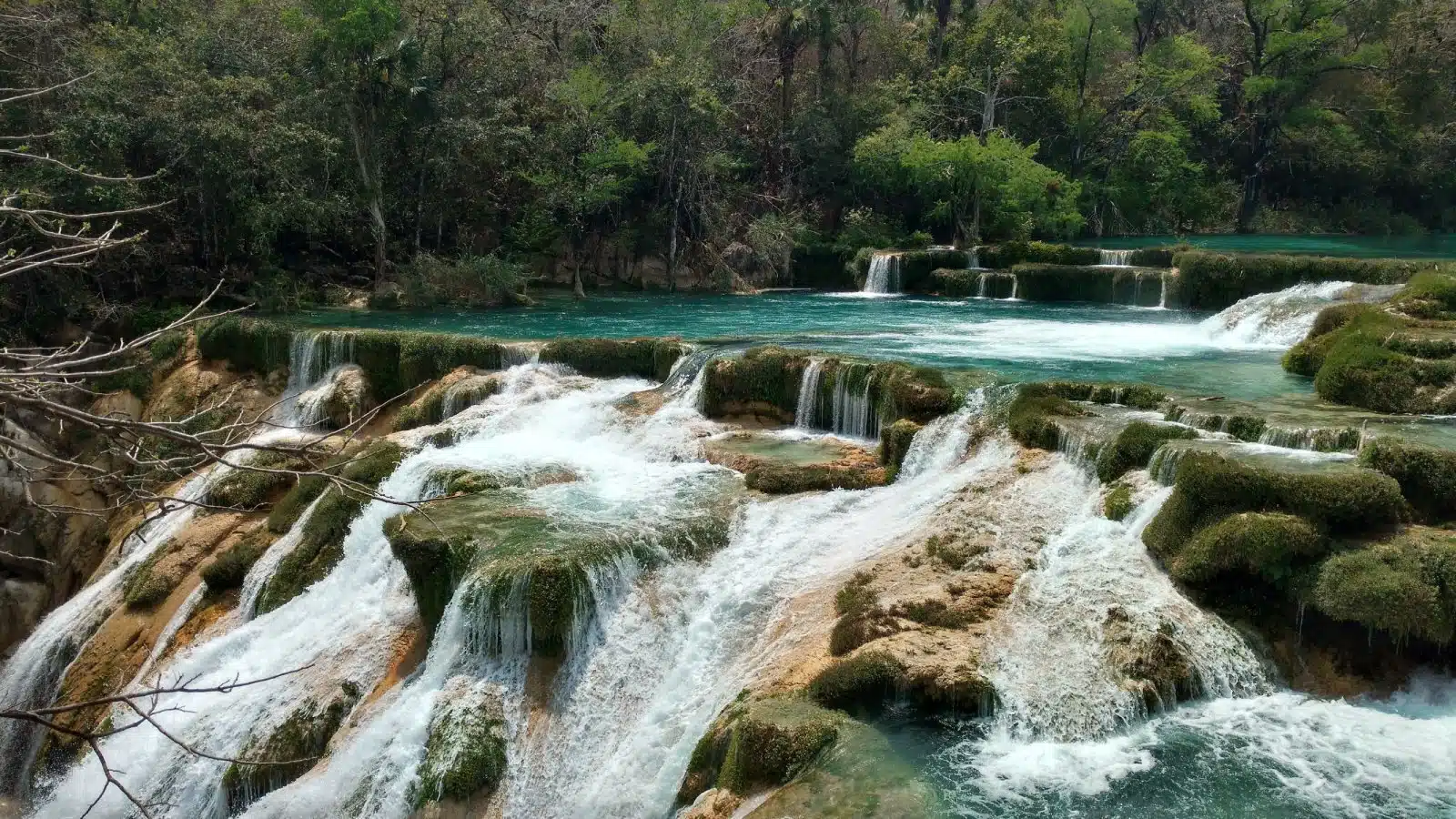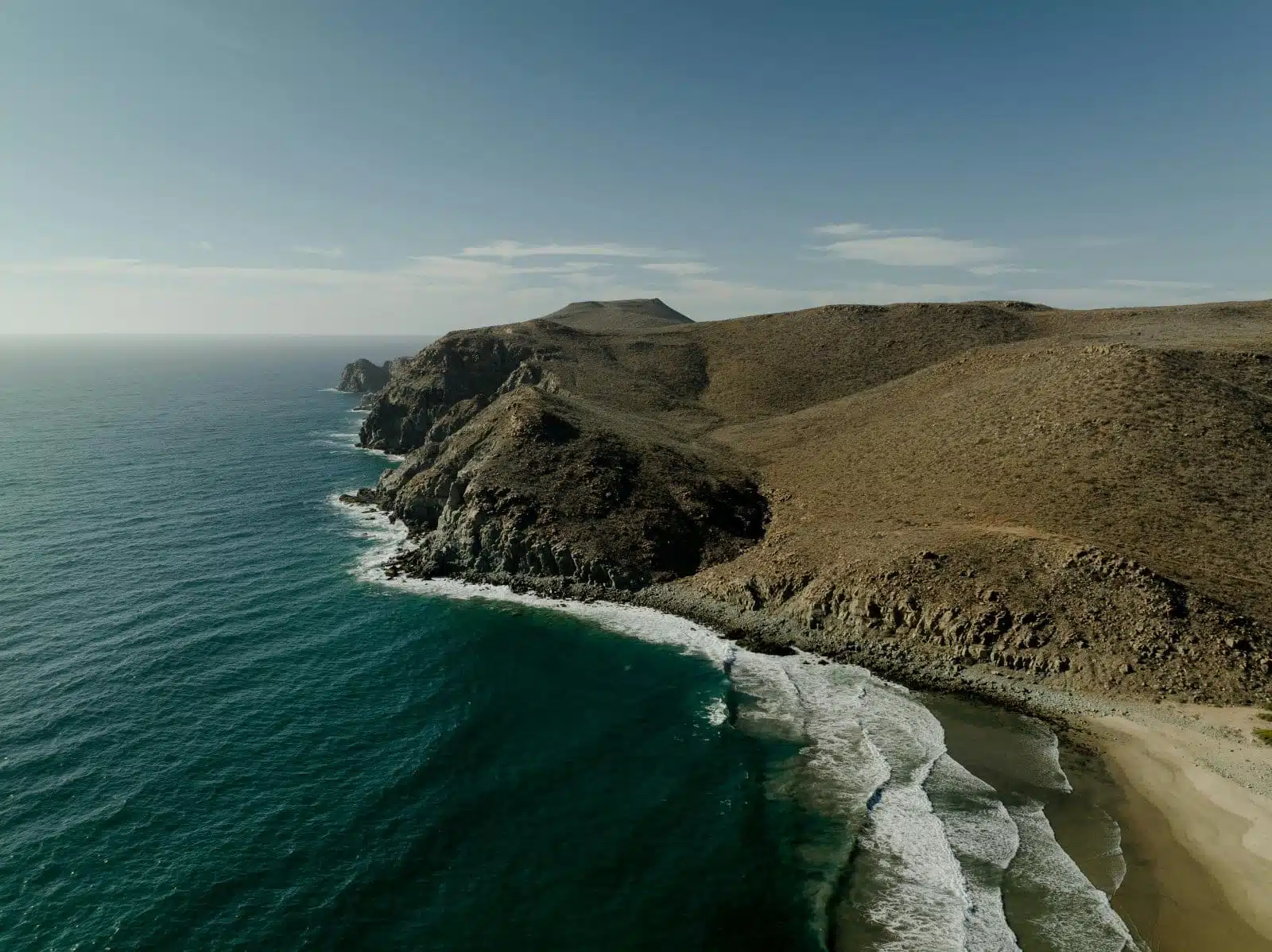Mexico, rich in culture, history, and natural beauty, offers far more to the discerning traveler than its world-famous beaches. Beyond the well-trodden paths to Cancún, Cabo, and the Mayan Riviera lie a treasure trove of lesser-known destinations that offer a glimpse into Mexico’s soul. This guide invites you to explore Mexico’s hidden gems, from the mystical streets of Valle de Bravo to the awe-inspiring depths of Copper Canyon. Discover cultural experiences, unique landscapes, and culinary delights that reveal the country’s authentic charm.
1. Valle de Bravo

Image Credit: Pexels / Jonathan Lassen
Valle de Bravo, a peaceful escape nestled in the mountains, offers a harmonious blend of natural beauty and rich cultural heritage. With its cobblestone streets and colonial architecture, this enchanting town sits on the edge of a tranquil lake, providing a picturesque setting for various outdoor activities. Paragliding enthusiasts will find the surrounding mountains an ideal launchpad for soaring above the landscape, offering unparalleled views of the lake and forested terrain. For those who prefer water-based adventures, Lake Avándaro invites visitors to sail its calm waters or kayak along its shores, with opportunities to spot local wildlife. The town, designated a Pueblo Mágico for its cultural significance, is a treasure trove of artisan shops, gourmet restaurants, and charming boutiques, each telling a story of Valle de Bravo’s heritage. The Monarch Butterfly Biosphere Reserve, a short distance away, offers a unique natural spectacle as millions of butterflies congregate during their annual migration, enveloping the area in a flutter of color and life.
Insider’s Tip
Don’t miss the chance to witness the monarch butterfly migration at the nearby Piedra Herrada Sanctuary, which is best visited between November and March.
When to Travel
The ideal time to visit Valle de Bravo is from October to May, when the weather is pleasant and the town is alive with cultural festivities.
How to Get There
Valle de Bravo is approximately a 2-hour drive from Mexico City. It is an accessible retreat from the capital’s hustle and bustle.
2. Copper Canyon

Image Credit: Pexels / Luke Barky
Copper Canyon, a majestic natural wonder, stretches across the Sierra Tarahumara in Northern Mexico, offering landscapes that rival the grandeur of the Grand Canyon. This vast network of canyons, characterized by its steep cliffs and deep ravines, is a paradise for hikers, cyclists, and adventurers seeking to explore its remote beauty. The Chihuahua al Pacifico Railway, an engineering marvel, snakes through the canyons, providing passengers with breathtaking vistas and access to otherwise inaccessible areas. The indigenous Rarámuri people, renowned for their endurance running, inhabit the region, adding a rich cultural layer to the natural beauty. Visitors can engage with Rarámuri communities, learn about their traditions, and perhaps witness a traditional footrace. The area’s flora and fauna are diverse, with pine-oak forests hosting a variety of wildlife, from majestic eagles to elusive deer, making Copper Canyon a comprehensive exploration of both culture and nature.
Insider’s Tip
Embark on a guided hike to remote areas of the canyon to experience the natural beauty and cultural richness up close. Stay in an eco-lodge to minimize your environmental impact.
When to Travel
The best time to visit Copper Canyon is from October to November or March to April, when the weather is mild, and the views are unobstructed by rain or fog.
How to Get There
The most common starting point for a trip to Copper Canyon is the city of Chihuahua, accessible by air from Mexico City and other major Mexican airports.
3. San Cristóbal de Las Casas

Image Credit: Pexels / Nataliya Vaitkevich
San Cristóbal de las Casas, set in the highlands of Chiapas, is a vibrant tapestry of indigenous cultures and colonial history. This cultural gem offers a deep dive into Mexico’s indigenous heritage with its colorful markets, cobblestone streets, and colonial churches. The town serves as a gateway to surrounding indigenous communities, where ancient traditions are preserved and shared with visitors. San Cristóbal’s local markets are a feast for the senses, overflowing with handwoven textiles, traditional crafts, and regional delicacies, reflecting the rich diversity of Chiapas. The town’s coffee culture is notable, with numerous cafes serving locally sourced coffee in cozy settings, perfect for experiencing the slower pace of life in the highlands. Cultural festivals, such as the Fiesta de San Cristóbal, fill the streets with music, dance, and traditional costumes, offering a glimpse into the town’s vibrant community spirit.
Insider’s Tip
Visit the indigenous towns of San Juan Chamula and Zinacantan to gain insight into the local Tzotzil and Tzeltal communities. Be respectful and considerate, especially when taking photographs.
When to Travel
The dry season from November to April offers the most comfortable climate for exploring San Cristóbal and its surroundings.
How to Get There
The nearest airport is in Tuxtla Gutiérrez, about an hour’s drive from San Cristóbal. Buses and shuttles are available for the transfer.
4. Guanajuato

Image Credit: Pexels / Pixabay
Guanajuato, a UNESCO World Heritage site, captivates visitors with its rich history, baroque architecture, and winding underground tunnels. This colorful city, built into a narrow valley, boasts a unique network of subterranean streets and alleys, offering a novel way to explore its charms. The city’s vibrant cultural scene is evident in its numerous museums, theaters, and galleries, hosting international events like the Cervantino Festival, which attracts artists and performers from around the globe. Guanajuato’s historic center, with its opulent churches and elegant colonial buildings, tells the story of Mexico’s colonial past and the wealth of silver mining. The city’s lively plazas, such as the Jardín de la Unión, are perfect for people-watching and enjoying local cuisine, while the panoramic view from the El Pípila monument offers a stunning overview of Guanajuato’s colorful landscape.
Insider’s Tip
Explore the city’s underground tunnel network on foot to experience Guanajuato’s unique urban layout and discover hidden plazas and street art.
When to Travel
October is an ideal time to visit, coinciding with the International Cervantino Festival. However, Guanajuato is beautiful and lively year-round.
How to Get There
Del Bajío International Airport is the nearest major airport, about an hour’s drive from Guanajuato. Direct flights are available from major cities in Mexico and the United States.
5. Bacalar

Image Credit: Shutterstock / ARZTSAMUI
Bacalar, known as the “Lagoon of Seven Colors,” is a serene paradise where the hues of blue and turquoise waters create a mesmerizing spectacle. This tranquil destination, far removed from the bustle of Mexico’s tourist hotspots, invites visitors to unwind and connect with nature. The lagoon, with its crystal-clear waters and soft, white sandbanks, is ideal for swimming, snorkeling, and sailing, offering peaceful alternatives to the crowded beaches of the Caribbean. Bacalar’s charm extends to its small town, where the pace of life is slow, and the atmosphere is welcoming. The nearby Cenote Azul, one of the largest cenotes in the Yucatán Peninsula, offers a unique swimming experience in its deep, fresh waters. For those interested in history, the San Felipe Fort provides insight into the region’s past, with stunning lagoon views and an informative museum dedicated to Bacalar’s pirate history.
Insider’s Tip
Take a sunrise kayak tour to experience the lagoon’s tranquil beauty at its most magical, with the added chance of having the water all to yourself.
When to Travel
The best time to visit Bacalar is from November to April, when the weather is dry, and the temperatures are comfortable for outdoor activities.
How to Get There
The closest airport is in Chetumal, about a 30-minute drive from Bacalar. Alternatively, Cancún International Airport is a 4-hour drive away, offering more flight options.
6. Oaxaca

Image Credit: Pexels / Andrea Piacquadio
Oaxaca, a vibrant city with color and culture, is a testament to Mexico’s indigenous heritage and colonial past. The city’s streets are alive with the energy of open-air markets, traditional festivals, and artisan workshops, offering a rich tapestry of experiences. Oaxaca’s culinary scene is unparalleled, with local specialties like mole, tlayudas, and mezcal drawing food enthusiasts from around the world. The surrounding valleys are dotted with ancient Zapotec ruins, such as Monte Albán and Mitla, providing a window into the region’s pre-Hispanic history. Oaxaca’s commitment to preserving its cultural traditions is evident in its thriving arts scene, with galleries and museums showcasing the work of local and international artists. The Guelaguetza festival, a highlight of Oaxaca’s cultural calendar, brings together communities from across the state to celebrate their customs, dances, and music, offering visitors a unique opportunity to witness the unity and diversity of Oaxacan culture.
Insider’s Tip
Schedule your visit to coincide with Día de los Muertos (Day of the Dead) at the end of October to experience one of Mexico’s most iconic celebrations in a city known for its elaborate festivities.
When to Travel
The dry season from October to May is the best time to visit, with numerous cultural events and festivals taking place.
How to Get There
Oaxaca’s Xoxocotlán International Airport has direct flights from Mexico City and other major Mexican cities, making it easily accessible.
7. Mérida

Image Credit: Pexels / Kampus Production
Mérida, the cultural heart of the Yucatán Peninsula, offers a blend of colonial history, Mayan heritage, and modern vitality. This elegant city, characterized by its limestone buildings and tree-lined avenues, serves as a living museum where the past and present coexist harmoniously. Mérida’s rich cultural offerings, from traditional Yucatecan cuisine to vibrant street art, reflect the diverse influences that have shaped the city. The bustling markets and lively plazas provide a glimpse into daily life in Mérida, while the city’s museums and galleries offer deeper insights into the region’s history and art. Just beyond the city, the ancient Mayan sites of Uxmal and Chichén Itzá await, offering a connection to the profound history and achievements of the Mayan civilization. Mérida’s commitment to cultural preservation is also evident in its numerous festivals and events, which celebrate everything from local music and dance to international arts and cinema.
Insider’s Tip
Don’t miss the opportunity to explore the city’s markets, where you can try local specialties like cochinita pibil and salbutes. Participate in a cooking class to bring the flavors of Yucatán back home with you.
When to Travel
The cooler months from November to February offer the most pleasant climate for exploring Mérida and its surroundings.
How to Get There
Mérida International Airport is well-connected with flights from the United States, Mexico City, and other parts of Mexico.
8. Puebla

Image Credit: Pexels / Polesie Toys
Puebla, set against the backdrop of the Popocatépetl and Iztaccíhuatl volcanoes, is a city where history, cuisine, and art converge. Renowned for its culinary heritage, particularly the invention of mole poblano, Puebla offers a gastronomic journey through Mexico’s flavors. The city’s historic center, a UNESCO World Heritage site, dazzles with its beautifully preserved colonial architecture and ornate churches, epitomized by the Puebla Cathedral and the Chapel of the Rosary. Puebla’s Talavera pottery, a traditional craft recognized for its intricate designs and vibrant colors, adorns buildings and homes, adding to the city’s aesthetic charm. Art enthusiasts will find a thriving contemporary art scene, with galleries and street art reflecting Puebla’s creative spirit. The city’s numerous museums, including the Amparo Museum and the International Museum of the Baroque, offer diverse cultural experiences, from pre-Hispanic artifacts to modern art.
Insider’s Tip
Visit the workshops of Talavera artisans to learn about the traditional methods of creating Puebla’s iconic pottery. Many workshops offer classes where you can try painting your own piece.
When to Travel
Spring (March to May) is a great time to visit Puebla, with pleasant weather and the city in full bloom.
How to Get There
Puebla’s Hermanos Serdán International Airport receives flights from major Mexican cities. Alternatively, it’s just a 2-hour drive from Mexico City, making it an accessible day trip or weekend getaway.
9. Huasteca Potosina

Image Credit: Shutterstock / DianaP
Huasteca Potosina, a region of unparalleled natural beauty, invites adventurers to explore its waterfalls, rivers, and caves. This lush area, characterized by its emerald-green waters and dense vegetation, offers a playground for outdoor enthusiasts, with activities ranging from kayaking in the Tampaón River to rappelling down the Minas Viejas waterfalls. The surreal Edward James Garden in Xilitla, with its whimsical sculptures set amidst the jungle, provides a unique artistic experience that blurs the lines between nature and imagination. Huasteca Potosina’s rich biodiversity is on full display in the Sótano de las Golondrinas, a massive open-air pit cave that serves as a sanctuary for thousands of birds. The region’s small towns and villages, with their warm hospitality and traditional cuisine, offer a glimpse into the daily life and cultural traditions of the Huasteca people, making Huasteca Potosina a destination where nature, culture, and adventure intersect.
Insider’s Tip
For an unforgettable experience, visit the surreal gardens of Edward James in Xilitla, a “surrealist” sculpture garden set amidst the jungle, blending art with nature in a way that has to be seen to be believed.
When to Travel
The rainy season from June to September is when the region’s waterfalls are most spectacular, though the area is beautiful year-round.
How to Get There
The closest major airport is in Tampico, Tamaulipas, or you can drive from San Luis Potosí city, which is about a 5-hour journey.
10. Todos Santos

Image Credit: Pexels / Josh Withers
Todos Santos, a coastal oasis on the Baja California Peninsula, offers a retreat for those seeking inspiration, relaxation, and connection with nature. This charming town, with its historic buildings, art galleries, and organic farms, exudes a laid-back atmosphere that attracts artists, surfers, and eco-conscious travelers. Todos Santos’s beaches, such as Playa Los Cerritos and Playa La Cachora, provide idyllic settings for surfing, whale watching, and sunset strolls. The town’s commitment to sustainability is evident in its eco-friendly accommodations and initiatives to protect local wildlife and habitats. Todos Santos’s vibrant cultural scene, highlighted by the annual Music Festival and the Todos Santos Film Festival, showcases the town’s creative spirit and community values. For those looking to explore the natural beauty of the Baja Peninsula, Todos Santos serves as a gateway to desert landscapes, mountain trails, and hidden waterfalls, offering a peaceful yet adventurous escape from the mainstream.
Insider’s Tip
Visit during the annual Todos Santos Music Festival. This charity event brings together international and local musicians for a series of concerts benefiting local charities.
When to Travel
The best time to visit Todos Santos is from November to May when the weather is ideal for surfing, hiking, and exploring the town’s cultural offerings.
How to Get There
Todos Santos is about an hour from Los Cabos International Airport, with car rentals and shuttle services available.
The Bottom Line

Image Credit: Pexels / Andrea Piacquadio
Exploring Mexico’s hidden gems offers a journey into the heart of the country’s cultural and natural beauty. Each destination provides a unique insight into Mexico’s diverse landscapes, traditions, and culinary delights, far from crowded beaches and resorts. As you venture beyond the typical tourist path, you’ll discover Mexico’s authentic charm and richness, creating memories that will last a lifetime. Whether you’re drawn to the tranquility of Valle de Bravo, the culinary heritage of Puebla, or the natural wonders of Huasteca Potosina, Mexico’s lesser-known destinations await with open arms and endless possibilities.
More From The Green Voyage
12 Best Practices for Sustainable Travel in 2024 – How to Travel With Minimal Environmental Impact
Unlocking Hotel Perks – A Traveler’s Guide to Maximizing Hotel Reward Programs for Optimal Benefits
Travel Hacks for Frequent Flyers – 6 Tips and Tricks to Make the Best of Air Travel
The post Beyond Mexico’s Beaches 2024 – Exploring 10 Hidden Gems first appeared on The Green Voyage.
Featured Image Credit: Pexels / RDNE Stock project.
For transparency, this content was partly developed with AI assistance and carefully curated by an experienced editor to be informative and ensure accuracy.
Tips for Trip Success
Book Your Flight
Find an inexpensive flight by using Kayak, a favorite of ours because it regularly returns less expensive flight options from a variety of airlines.
Book Your Hotel or Special Accommodation
We are big fans of Booking.com. We like their review system and photos. If we want to see more reviews and additional booking options, we go to Expedia.
You Need Travel Insurance!
Good travel insurance means having total peace of mind. Travel insurance protects you when your medical insurance often will not and better than what you get from your credit card. It will provide comprehensive coverage should you need medical treatment or return to the United States, compensation for trip interruption, baggage loss, and other situations.Find the Perfect Insurance Plan for Your Trip
